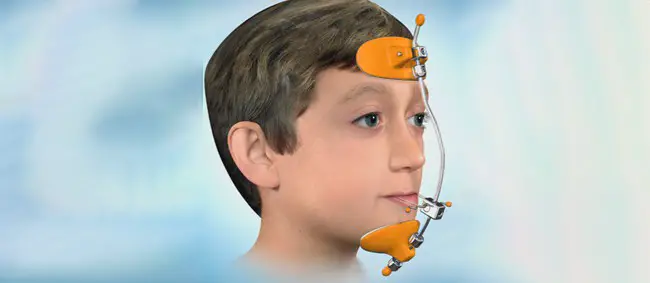
So you might have read about face-pulling sometime during your mewing journey. But what exactly is it?
Face-pulling is a technique for pulling forward the maxilla. This can be an adjunct to mewing to help guide growth or have the maxilla remodel in a more forward (attractive) direction. You can accomplish this with devices or your thumbs.
Read on to find out how it works and if you can use it to supercharge your results.
How Does Face-Pulling Work
Face-pulling works similarly to mewing. You apply a force to your upper palate, and this forces your bones to remodel in response to that force. This is normally done with the thumbs or a device that fits inside your palate and is then connected to the attached orthodontic headgear.
Remember that your bones change as they age. In adults, the bones remodel at a rate of 10% per year. See the aging skeleton (Eduardo et al, 2017):
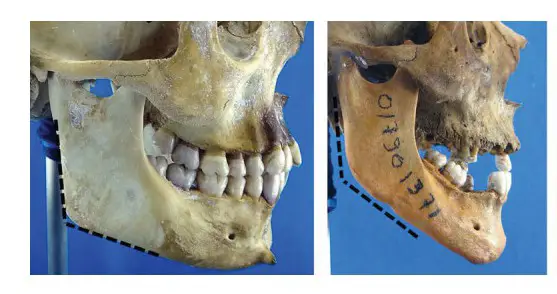
Note the decrease in gonial angle and overall lengthening of the face. These changes happen whether you like them or not. So our goal is to get these changes to occur in the other direction. We want to get better looking with age, not worse.
When you exert constant pressure on a bone, it remodels out of the way of that force.
See Stephen Hawking, a victim of ALS, or Lou Gehrig’s disease. He started normally. But ALS is a disease of the muscle, not the bones. As he began to lose control of his muscles, the normal stimulus on his bones began to vanish. Over time, this leads to warping of the bone.

It’s a similar concept to muscular dystrophy, which causes weakness and loss of muscle mass. The man below did not start with a recessed maxilla or an open bite:
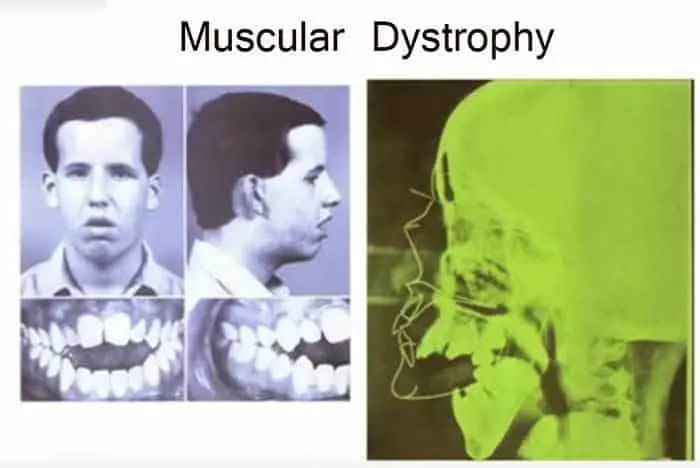
Muscular dystrophy destroys the normal stimulus that exists on your facial bones. Over time, this warps the skull into a non-optimal shape.
So face-pulling works via the same concept, only you’re pulling the bones in the direction of optimal growth. This is usually done via orthodontic headgear. A mold of your upper palate or a retainer is placed into your upper palate. The orthodontic headgear then pulls forward on your palate, such as like in this example:
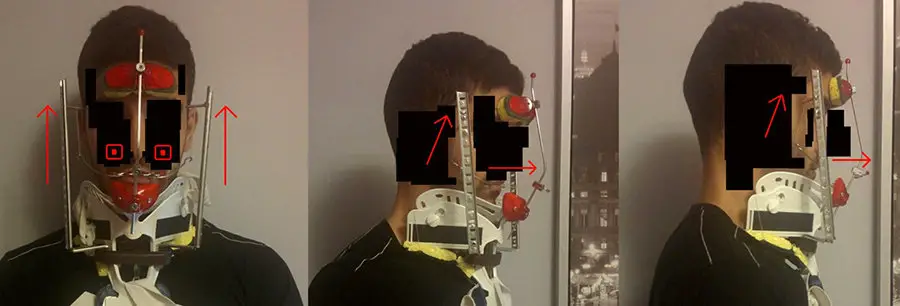
This is a home-made device attached to a neck brace. The arrows show the direction of the force being applied by the device. The recommended wearing time is 12-18 hours a day.
Orthodontic headgear to correct underbite is also given to children. This is called reverse-pull headgear or a reverse-pull facemask. This can fix the malocclusion between the upper and lower jaws by moving the upper jaw forward.
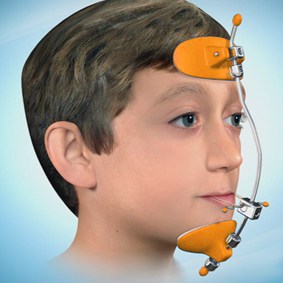
Another face-pulling technique is thumb-pulling. This involves pressing inwards and upwards on your palate to both expand it, and to pull it forward.
Is Face-Pulling Effective?
But does this hold up in practice? Simply put, we don’t know yet. There haven’t been scientific studies done on face pulling in humans. But we know that mewing works and that small forces can change the maxilla over time. We also know that reverse pull headgear in children can correct underbites. Therefore, extrapolating this to face-pulling indicates that it should work.
Thumb pulling is a different story because the pressures that you put with your thumb, while intense in force, are only for a short duration. This contradicts the tropic principle that small forces over a long period lead to change.
Furthermore, biomechanics and regular mechanics are not the same. Wolff’s law states that bones will remodel harder and stronger to resist pressures put on them. It’s possible that thumb-pulling and perhaps even face-pulling is too strong of a force. It might be above the threshold where Wolff’s law kicks in, whereas regular mewing is not. If so, this will make it hard to see gains as an adult because the bones will remodel to resist the force you exert.
Mewing on the other hand is more constant and might be just under the threshold for Wolff’s law. This would allow the stimulus for remodeling to be present for far longer than it would be with face-pulling, yet not trigger bone hardening with Wolff’s law.
What About The Mandible?
Face pulling works in children for both the upper and lower jaws because the mandible is still growing. However, after the ages of 17 for girls, and 19 for boys, the mandible stops growing. It can still remodel. But does this mean that face-pulling in and of itself will allow your mandible to grow more forward?
I don’t believe it does. Facepulling exerts a force on the maxilla, but the question is whether it translates to the mandible. It’s both possible that since the upper and lower jaws are locked together by the teeth, that this means both jaws will remodel together. Unfortunately, some face pulling methods require you to keep your teeth open to make room for the device.
You may be able to pull the maxilla forward, but you also need a plan for the mandible. Face pulling appliances exert no direct effect on the mandible, and it is not going to grow just by itself.
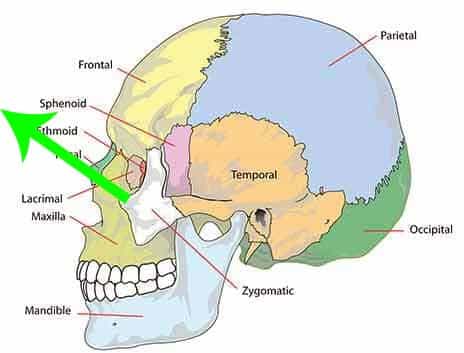
However, note that the maxilla is a slave to the mandible. As the maxilla moves upward and forward, the mandible, starting from the TMJ, rotates upward to meet it. The teeth, with a normal bite, are locked together and ensure that the two jaws rotate upwards in unison.
Benefits
The benefits of face pulling are akin to the benefits of mewing. This means:
- Hooded eyes
- Forward growth
- More square jaw
- Palatal expansion
- Maxilla support for the under-eye area
- Support for nasal tissue (straight nose)
- Cheek hollows
- Wider face
- Easier to nose breathe
- Reduced risk for sleep apnea
It’s all the same benefits as mewing, but at the prospect of reaching your goals even faster.
Thumb-Pulling
Thumb-pulling is the same overall concept as wearing face-pulling orthodontic headgear, but you’re pressing much harder and you’re pressing with your thumbs. Here’s how to thumb-pull:
- Take two thumbs, and place each one on the inside of your upper palate by the molars, with your fingers on your cheekbones.
- Push on your palate upwards toward your cheekbones, and hold for 30 seconds.
- Start from the back and work your way to the front of the mouth.
- When you get to the front of the mouth, push upwards and forwards with both of your thumbs.
When you get to the front of the mouth, if you can’t fit more than one thumb, just slide it outwards to make room for your other thumb. Start with 2-3 sets per day, every day.
Remember the tropic premise:
Small Force & Long Duration > Strong Force & Shorter Duration
Whether the large force generated by your thumbs is enough to kickstart and augment the remodeling process, or whether Wolff’s law kicks in and it makes it worse remains up for debate. What we do know for a fact is that some users have expanded their palates with thumb pulling.
But keep in mind that palatal expansion in itself isn’t that impressive because the teeth sit in the alveolar bone, which has the fastest bone metabolism of the whole body (Jonasson et al, 2018). So even if this works for your palate, there’s still not enough information about what it will do to your whole maxilla and mandible.
Palatal expansion is possible in adults. This is also dependent on individual biology. Some adults can have their palates expanded, some can’t. Ultimately, you won’t know if thumb pulling will work for you unless you try it.
Belt-Pulling
This ill-advised fad started in the looksmaxing community as an attempt to face pull at home. People would tie a belt around their upper palate and tighten it to the top of their heads. Or they would hang themselves from their upper palate. It did not end well for most users who have messed up their faces, teeth, or some combination.
Needless to say, do not attempt this.
Safety & Side Effects
As I alluded to earlier, it’s possible that moving the maxilla forward too fast won’t leave enough time for the mandible to catch up. This makes mewing the safer option overall.
With face-pulling, the risks are similar to that of palate expanders:
- Pain
- Sore Tongue
- Sore Teeth
- Trouble With Pronunciation
- Space Between Two Upper Front Teeth
- Damage to Buccal Bone, Alveolar Bone
Realistically, if you keep the force low and don’t go overboard, none of these should be a problem. With thumb-pulling, some users report hearing a pop/crack come from their maxilla.
Creating face-pulling devices at home magnifies any potential risks. A doctor will use medical grade equipment and measure the force being exerted on each part of your mouth.
Dr. Mike Mew previously stated that face pullers work, but that you shouldn’t mess around with home-built devices.
Face-Pull Headgear vs. Thumb-pulling
Thumb-pulling is free, and your hands can be a great palatal expansion tool. But face-pull headgear is going to be much more efficient at face-pulling than thumb-pulling can be. Remember that face-pulling on children works because it’s worn for most of the day (12-18 hours). A thumb pulling session might last 30 minutes or an hour if you’re dedicated.
Also, remember Wolff’s law. Bones will remodel to better resist forces placed upon them. You don’t want to press too hard, and the face-pull headgear can be modified to use the perfect amount of force unlike thumb-pulling.
If you have to pick one or the other, face-pull headgear is superior to thumb-pulling.
Face-Pulling vs Mewing
So we know that face-pulling and mewing work on extremely similar principles. Face-pulling can be superior to mewing because the force is much stronger, and also because the force is controlled by a device. This means the force is spread out evenly, and it is constant. Your tongue cannot guarantee constant and even pressure as a face-puller can.
But the other main difference lies in the antagonist muscles. One of these is masseter muscle:
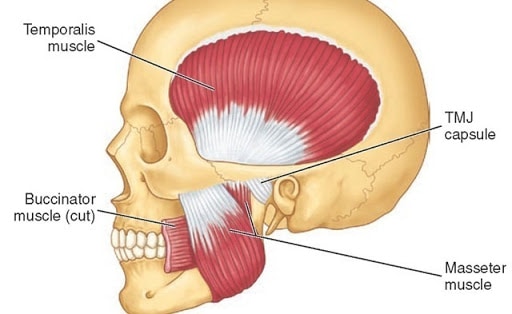
There are also the hyoid muscles of your submental region:
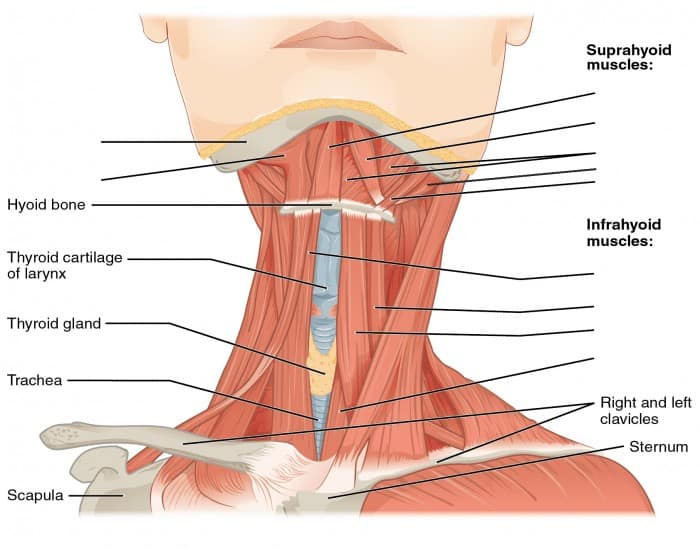
These muscles push upwards to counteract the tongue. This means that they are exerting a force on the mandible as well. This leads to the facial upswing and possible mandibular growth that you get from mewing. This is pretty important, as this is how nature designed us to achieve our ultimate forms.
But what are the antagonist muscles of a face-puller? They don’t exist, which is the problem. Or, it’s the device itself. Where mewing would be analogous to a full-body exercise, a face puller is analogous to just working out the bicep.
Again, if you go too far with face-pulling, you might pull your maxilla forward. But you don’t know for a fact if your mandible will have time to catch up. Mewing is a far more holistic approach to optimizing your face. Slow and steady wins the race.
Face-Pulling vs Surgery
The benefits of surgery are immediate, gratifying results. But they come with risks, a steep cost, and potential complications. You will have to relearn how to swallow, and it’s possible that the surgery will remove your hard palate. This will make it impossible for you to mew or face-pull ever again.
You might be able to get a maxillary advancement surgery, or a LeFort to move your maxilla forward. If you just want to face-pull, it would take months/years but the result would be natural and you wouldn’t be in pain.
It’s possible that if you succeed in pulling your maxilla forward, you might have to get surgery on your mandible anyway. So, you just have to weigh the pros and cons.
Face-Pulling vs Palatal Expansion
Both face-pulling and palatal expansion are effective at expanding the palate. But if palate expansion is your goal…then get the palatal expander. There’s no reason why you should avoid getting one if you have the money. That’s what it’s for unlike a face-puller.
But, if facial aesthetics are your only goal, face-pulling will help you achieve your results much faster.

Age Considerations
Just remember that your treatment should be different when based on your age range. Children should go see an Orthotropist or Forwardonist. Their bones are still highly malleable and it won’t take much work to get them to change.
Teenagers should just focus on mewing. They are still growing, and guiding the growth is more important than forcing the bones to change.
People in their 20s and above might consider face-pulling.
Where to Get Face-Pulling Done
As of now I suggest you stay away from home-built devices and even thumb-pulling. Remember that the benefit of face-pulling is that the force/and pressure is evenly dispersed unlike with the tongue. You’re not getting that with a home-built device and are potentially exposing yourself to risk.
Thumb-pulling can’t hurt in moderation, but it also has some risks.
If you have to get a face-pulling device, I suggest you see a doctor that can create a device for you. But without an actual health condition to justify such a device, however, you’ll be hard-pressed to find a doctor who will build you one.
If you decide to pursue the path of face-pulling, working with a physician is your safest bet and I wish you luck.

